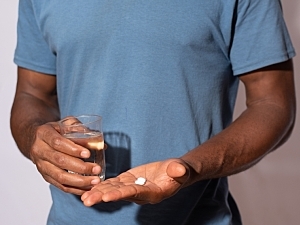One component of frailty is mobility limitation, which is often measured as walking speed. Brigham and Women’s Hospital researchers previously demonstrated associations between slow walking speed, mortality, and new-onset cardiovascular disease (CVD) events in Atherosclerosis. Others have shown frailty and impaired mobility have a bidirectional relationship with CVD. That suggests pharmacologic therapies targeting CVD might be able to reduce the risk of mobility limitation.
Ariela R. Orkaby, MD, MPH, a geriatrician–epidemiologist in the Division of Aging at the Brigham, and colleagues used data from the Physicians’ Health Study I to study the relationship between long-term aspirin use and self-reported walking speed. In The Journal of Frailty & Aging, they say men who started aspirin use in middle age had a greater probability of faster walking speeds in late life than men who reported low aspirin use. The associations were strongest among older men with a history of heart disease.
Methods
The Physicians’ Health Study I was a double-blind, 2×2 factorial trial that randomized 22,071 male physicians to either 325 mg aspirin or placebo every other day and to beta-carotene or placebo, beginning in 1982. At the start of the trial, participants were free of CVD.
In 1988, the aspirin intervention ended early because it was associated with a significant reduction in myocardial infarction. 70% of the placebo group crossed over to aspirin. Participants completed annual questionnaires about clinical variables, medications, and lifestyle until 2012. Questions about typical walking pace were part of the questionnaires from 2001 to 2003 when all participants were ≥58 years old.
For the analyses in the current study, 14,315 participants were divided into two groups based on cumulative aspirin exposure: ≤60 days/year (14%) or >60 days/year (86%). Assignment to beta-carotene versus placebo was disregarded. At the time of walking speed assessment, the cohort’s mean age was 70 (range, 58–100) and the mean duration of aspirin use was 11 years (range, 0–18).
Overall Results
Because aspirin use became nonrandomized in the trial, the research team developed a propensity score to balance the degree of aspirin exposure over up to 15 years of post-intervention follow-up. The two aspirin groups were similar with respect to initial randomization; variables that might be related to post-intervention aspirin use (e.g., history of bleeding, heart disease); and health-related risk factors and outcomes (e.g., smoking history).
The researchers observed a graded association between regular aspirin use and faster walking speed (P-trend <0.001):
- The relative odds of being in the “easy pace” group (<2 mph) instead of the “don’t walk” group were 16% greater with high aspirin exposure vs. low aspirin (P=0.38)
- “Normal pace” group (≥2 to 2.9 mph)—24% greater odds (P=0.02)
- “Brisk pace” group (≥3 mph)—40% greater odds (P=0.03)
Subgroup Analyses
The team explored whether aspirin use is more effective in certain disease states that can be affected by aspirin use. The only subgroup with a statistically significant interaction was men with a history of coronary heart disease. There was a non-significant suggestion of greater benefit among men who did not exercise regularly.
Intriguing Therapeutic Implication
The only therapies proven to prevent mobility limitation are exercise and leisure-time activity. These results suggest that regular aspirin use might prevent decreased walking speed, independent of medical history and health behaviors. This intervention would optimally be started in middle age when risks of aspirin are minimal.
